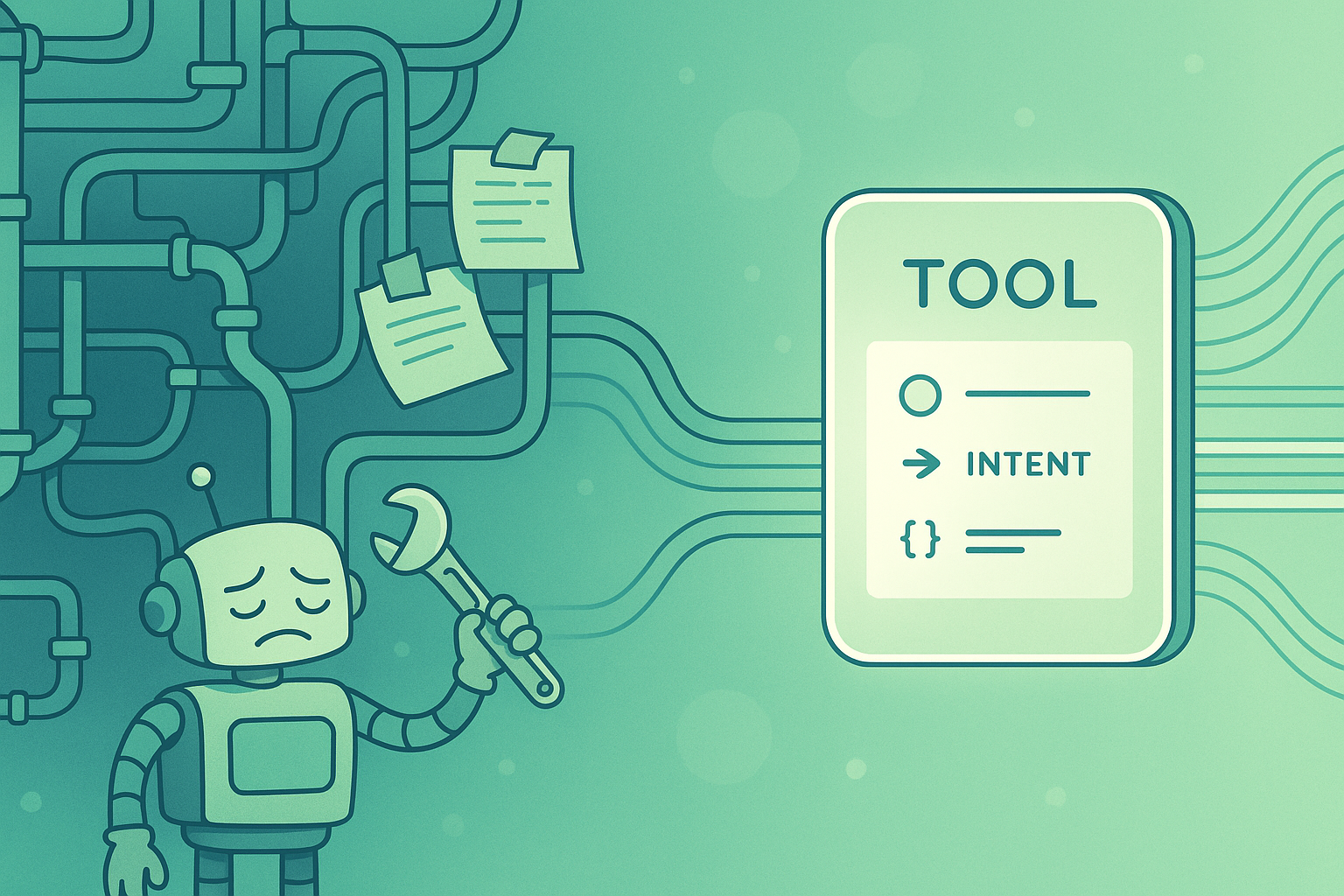
Why the Future of AI Integration Depends on Tooling Infrastructure
In theory, connecting agents to tools should be simple. Just expose a few endpoints, wrap them in a function call, and voilà! You have LLMs that take action.
Unfortunately, the reality is that it’s never just one wrapper, and it’s never just once. AI integration, despite all the hype, is still a painful slog. You write the tool. Then you write the prompt to explain the tool. Then you write the fallback logic for when the agent ignores the prompt. Then you wrap the output. Then you adjust the system message. Then you try it all again, while the LLM bashfully tells you that you’re right, it should work, while hallucinating some reasons for why it doesn’t.
And that’s just for one tool. Multiply that by ten, or fifty, or an entire enterprise stack, and the dream of reasoning agents quickly turns into a reality of hours, if not days or weeks, of frustration. Yes, there is an underlying element of tool complexity, but mostly, the current approach just isn’t scalable. Is there no way out of this mess? That’s the question this blog is here to answer.
Why Agent Tooling Breaks So Easily
Long before the tool itself fails, the agent tooling breaks in the layers around it: the logic scattered between a system prompt, a few helper functions, a fallback in your orchestration layer, and maybe a JSON config that someone edited two weeks ago and forgot about.
Each layer knows something the others don’t. A constraint here, a usage hint there, a naming quirk that only works because of an undocumented few-shot. Nothing lives in one place, nor travels with the tool.
# tool.py
@tool(name="cancel_order")
def cancel_order(order_id: str):
"""Only works if the order is not yet shipped."""
// tool_config.json
{
"auth_required": true,
"allowed_states": ["processing", "unfulfilled"]
}
# orchestration.py
system_prompt = """
Use `cancel_order` only if the customer asks to cancel something they just ordered.
Ignore if the item has already shipped.
"""
So when something stops working, like when the agent calls the wrong function or uses the wrong parameter or just forgets the tool exists, it’s almost impossible to trace.
The Maintenance Trap of Agent Tooling
This might all feel manageable at first. Just a little wrapper here, just a small prompt tweak there… just a few more config files, just a few more minutes going back and forth to finetune agent behavior. But over time, all those little “justs” start to pile up. Doing all of this manually “just” isn’t scaleable.
What if you have to duplicate tool logic across different agents? Which tools have which constraints? Suddenly, tools that should be reusable, like “get_customer_profile” or “create_support_ticket” functions, end up slightly different in every workflow. There’s no standard, no registry, no contract that travels with the tool. Which means when something breaks, it’s not the system that tells you. It’s you, squinting at logs and wondering whether the LLM somehow misunderstood the word “account.” (Hey, it could happen!)
How to Create Tooling That Scales
If you want agents to work reliably across tools, systems, and workflows, you need more than decorators and prompt instructions. You need a shared contract… something that travels with the tool and explains how, when, and why it should be used.
This is the beauty of the Model Context Protocol (MCP). MCP provides a structured way to describe tools not just in terms of input/output, but in terms of intent, constraints, context, and behavior. It gives agents something to reason about. And it gives developers a format that actually scales.
Here’s what an MCP-aligned tool might look like:
{
"name": "cancel_order",
"description": "Cancel an active customer order.",
"intents": ["order_management", "customer_service"],
"constraints": {
"allowed_states": ["processing", "shipped"],
"auth_scope": "orders:modify"
},
"output_schema": {
"confirmation_number": "string",
"cancellation_status": "string"
}
}
The meaning travels with the method, so you’re not “just” relying on scattered hints buried in comments or prompt strings. This allows:
- The orchestration layer to route intelligently
- The agent to select based on semantic fit
- The runtime to enforce usage rules automatically
Instead of rebuilding the logic each time, you define tools as semantic assets, something that’s discoverable, interpretable, and enforceable across environments.
Building the Infrastructure That Will Power the Next Wave of Agentic AI
Every organization experimenting with agents eventually runs into the same ceiling: integrations that don’t generalize. You can patch, prompt, and re-wrap for a while, but each quick fix deepens the dependency on brittle logic.
The real challenge is making hundreds of agents reliable, secure, and interoperable across systems that evolve daily. That requires an interface layer designed for cognition and governance, not just connectivity.
The teams that get this right are already shifting how they think about tooling. They’re treating it as shared infrastructure, something that encodes meaning, context, and policy directly into the interface itself. When that happens, every agent inherits a consistent understanding of what it can do, when it should act, and under what constraints.
That shift turns tooling from a maintenance burden into an architectural advantage. It brings visibility where there was guesswork, safety where there was trust, and speed where there was fragility.
The next generation of agentic AI will be defined by the infrastructure beneath them—the semantic layer that lets intelligence and enterprise systems finally speak the same language. And the organizations that start building it now will own the operating fabric of intelligent software.
Customized Plans for Real Enterprise Needs
Gentoro makes it easier to operationalize AI across your enterprise. Get in touch to explore deployment options, scale requirements, and the right pricing model for your team.

